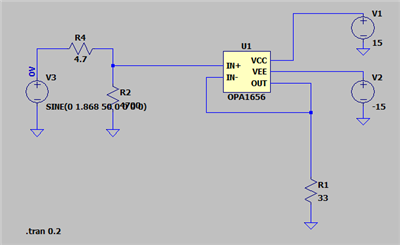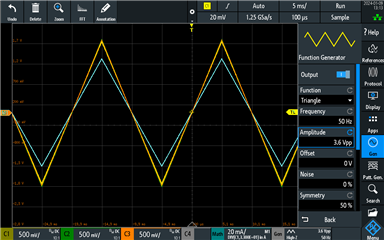- Ask a related questionWhat is a related question?A related question is a question created from another question. When the related question is created, it will be automatically linked to the original question.
This thread has been locked.
If you have a related question, please click the "Ask a related question" button in the top right corner. The newly created question will be automatically linked to this question.

Hello, i want to ask a question about the OPA1656.
I connected the component as shown in the figure (both channels), supplying them with ±15V.
The component must replicate the input signal without a gain but giving it more current capabilities, since it have to pass througth a 33R resistor (60 mA max).

The result is saisfying (the green signal is the input, and the orange and yellow ones are the output. The blue is the calculated current. The image shows a trianguar wave but the results is perfect also with all other waveforms.
Now the problem: the component becomes very hot (over 120°C or 248°F when i turned off everything but it was still increasing) during run and stay at around 92°C or 200°F when supplied but not working).
I also noticed that lowering the supply voltage to ±5V dramatically reduce the heat (60°C or 135°F) in running condition, around 35°C or 95°F in only-supplied condition.
Is this normal? Did I do something wrong? Any help will be appreciated.
Hi Alberto,
What you are describing is normal. We have a section in our online training video series that details power and temperature of op amps. The video series can be found here:
https://www.ti.com/video/series/precision-labs/ti-precision-labs-op-amps.html
The theta JA needs to be used to determine the approximate die temperature for your conditions.

There is a 119.9 degree rise in temperature for every watt that the amplifier is dissipating. We need to determine how many watts based on your conditions.
There is 30V total across the output stage and the Iq for a dual is 3.9 mA * 2 = 7.8 mA. Are you dissipating 60 mA per channel for 120 mA total?
Assuming 120 mA total from the chip we can approximate the total power.
This is the theoretical value of where the temperature would go but we have thermal shutdown protection built into the device in order to protect it from being destroyed. Temperatures beyond the abs max of 150 degrees C may permanently damage the device. You could potentially consider a power op amp such as the LM3886 for driving this much power.
I hope this helps. Let me know if you have further questions.
Best Regards,
Chris Featherstone